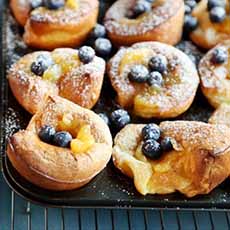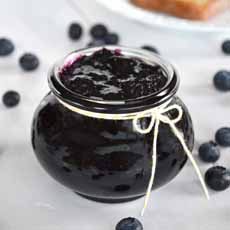FOOD HOLIDAY: National Blueberry Popover Day and Cherry Popover Day
|
|
March 10th is National Blueberry Popover Day. March 3rd is National Raspberry Popover Day and September 1st is National Cherry Popover Day. That’s three opportunities to enjoy flavored popovers and you can make classic popovers any day. Surprisingly, there is no National Popover Day, although plain popovers are divine—perhaps our favorite bread. Popovers are delicate, almost hollow “rolls” that majestically rise up over the tops of the pans they’re baked in (i.e., they pop over). The outsides are crisp and brown, the interiors soft and airy. The tops “pop over” the baking tin. In the U.K. they’re called Yorkshire pudding and are often served as a side with a slice of prime rib or other beef (see the exact difference between a popover and Yorkshire pudding below). In the U.S., they’re enjoyed as a special substitute for rolls or biscuits and are often served at brunch with butter or jam (although neither is required). Popovers are not difficult to make. The only challenge is to serve them quickly since as they cool they deflate. You can reheat leftovers in the microwave. They won’t return to their original puffiness, but they’ll still be yummy. > The history of cherries. If you don’t want to add the dried fruits, simply leave them out of the recipe. You can make savory variations by adding garlic, herbs, or other flavorings. You can even bake them, fill them (e.g., with scrambled eggs and bacon in photo #5), and bake them a little longer. You can also celebrate the holidays by serving blueberry or cherry preserves with plain popovers (photos #3 and #4). Ingredients For 12 Popovers 1. PREHEAT the oven to 425°F. Place one rack in the lower third position, topped with an empty baking sheet 2. PLACE 1/2 teaspoon of butter into each well of a 12-well muffin pan; set aside. 3. PLACE the remaining 1 tablespoon of butter, the eggs, milk, sugar, and salt in a blender and blend until smooth, about 30 seconds. Turn off the blender, add the flour, replace the lid, and blend until just smooth, about 30 seconds. Set the mixture aside in the blender. If you don’t have a blender, whisk thoroughly in a bowl. 4. PLACE the muffin pan on the heated baking sheet in the oven, and bake until the butter sizzles, about 2 to 3 minutes. Remove the muffin pan and the baking sheet from the oven (you can place them on the stovetop). Fill the wells of the muffin pan halfway with batter. 5. RETURN the muffin pan and baking sheet to the oven. Note: After you do this, do not open the oven door at any time during the baking period! Bake until the popovers have puffed up and the tops are starting to brown about 20 minutes. Reduce the oven temperature to 350°F and bake until the popovers are golden brown all over, about 15 minutes more. 6. REMOVE the muffin pan and baking sheet from the oven and place them on a wire rack. Remove the popovers from the pan and serve immediately. The popover is an American version of Yorkshire pudding, a batter pudding made in England since the 17th century [source]. Both use the same batter. The difference: |
|
|
Popovers are related to a now classic British dish, originally called Dripping Pudding. The first recorded recipe of dripping pudding appeared in 1737 in The Whole Duty of a Woman (modern readers: do not grimace!). Eight years later a popular 18th-century English cookbook writer, Hannah Glasse, published the recipe in The Art of Cookery Made Plain and Easy. She renamed it Yorkshire Pudding—it is not known why. She wasn’t from Yorkshire and dripping puddings were not particular to that area. Perhaps, with a writer’s flair, she wanted a name that sounded better than “dripping”; or perhaps she wanted it to appear that she had created the recipe (the earlier book was not widely known and the recipe was anonymous). The recipe crossed the pond where its name changed again in an American cookbook. Some sources place the first cookbook appearance of popovers was Mary F. Henderson’s Practical Cooking & Dinner Giving, published in 1876 (and sometimes cited as M.N. Henderson). The following year, Buckeye Cookery, first published in 1877. The cookbook called them “Pop-Overs.” They were Dripping/Yorkshire Puddings without the drippings. It became one of the premier American cookbooks of the 19th century. The oldest known written reference to popovers is in a letter that dates to 1850 [source]. CHECK OUT WHAT’S HAPPENING ON OUR HOME PAGE, THENIBBLE.COM.
|
||







